Colloquia for Spring 2012
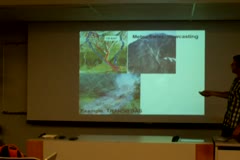
Organization and Structure of Orographic Convection Producing Flash Floods in Southern Switzerland
July 26, 2012
Luca Panziera (MeteoSwiss)
Hosted by Russ Schumacher
Special seminar.
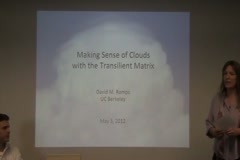
Making Sense of Clouds with the Transilient Matrix
May 03, 2012
David Romps
Hosted by Sue van den Heever
Clouds transport water, trace gases, and momentum through the atmosphere in a way that is not at all "diffusive". Instead, clouds transport these things in a "transilient" way, jumping across whole layers of the atmosphere. As a result, the convective tendencies of water, dust, trace gases, momentum, etc. are most accurately diagnosed -- and modeled -- using the so-called "transilient matrix"…
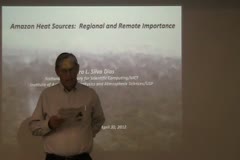
Amazon Heat Sources: Regional and Remote Importance
April 30, 2012
Pedro L. Silva Dias
Hosted by Wayne Schubert
The South American Monsoon System (SAMS) is now clearly recognized as one of the major features of the tropical circulation. The South Atlantic Convergence Zone (SACZ) and the Amazon Heat Source, are major features of the SAMS and constitute important heat sources with regional and remote influences, with significant diurnal, synoptic, intraseasonal, decadal or multi-decadal variability. I will…
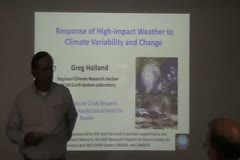
Response of High-Impact Weather to Climate Variability and Change
April 05, 2012
Greg Holland (NCAR)
Hosted by Wayne Schubert
Societal vulnerability to weather arises largely from relatively rare events at the extremes of the spectrum. Examples include: extended droughts, heat waves, major hurricanes, extreme local rainfall and snowfall, ice storms, European wind storms, and severe local storms and tornadoes. Our vulnerability to property loss and societal disruption also is increasing as society becomes more complex…
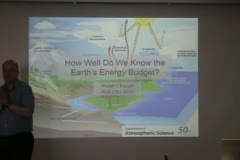
How Well Do We Know the Earth’s Energy Budget?
March 29, 2012
Tristan LÂ’Ecuyer
Hosted by Jeff Collett
Our ability to predict climate change is fundamentally connected to our understanding of the processes that govern global energy balance. Changes in global temperature are ultimately governed by the net flux of energy into the Earth-atmosphere system while the time-scales of responses to energy imbalances is largely governed by the partitioning of this energy between the atmosphere and the…
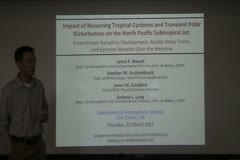
Impact of Tropical Cyclones and Transient Polar Disturbances on the North Pacific Subtropical Jet: Downstream Baroclinic Development and a Subsequent Intense Cyclone Event over the United States
March 22, 2012
Lance Bosart (University at Albany/SUNY)
Hosted by Russ Schumacher
Observations suggest that the latitudinal location, longitudinal extent, and overall strength of the North Pacific subtropical jet (STJ) can vary on intraseasonal and synoptic time scales in response to poleward- directed diabatically driven upper-level outflow associated with tropical heating anomalies and tropical cyclones (TCs), and equatorward-directed flow associated with the passage of…
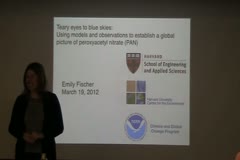
Teary Eyes to Blue Skies: Using Models and Observations to Establish a Global Picture of Peroxyacetyl Nitrate (PAN)
March 19, 2012
Emily Fischer
Hosted by Eric Maloney
Most reduced trace gases emitted into the atmosphere are removed by oxidation including greenhouse gases, air pollutants, and aerosol precursors. The primary atmospheric oxidants, the hydroxyl radical (OH) and ozone (O3), play critical roles in chemistry-climate feedbacks. Peroxyacetyl nitrate (PAN), formed in the atmospheric oxidation of non-methane volatile organic compounds (NMVOCs), serves…
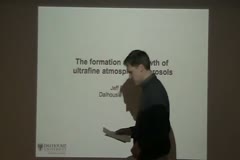
The formation and growth of ultrafine atmospheric aerosols
March 08, 2012
Jeffrey Pierce (Dalhousie University)
Hosted by Eric Maloney
Atmospheric aerosols have important influences on climate through their interaction with clouds and radiation. The extent of aerosols' climate impact depends greatly on the aerosol concentration, size and composition. A major source of aerosol particles in the atmosphere is nucleation, where low-volatility vapors combine to form ~1 nm diameter particles. These particles must grow to diameters…
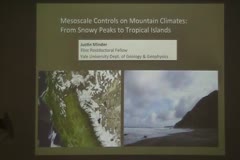
Mesoscale Controls on Mountain Climate - From Snowy Peaks to Tropical Islands
March 01, 2012
Justin Minder (Yale University)
Hosted by Richard Johnson
We still largely lack a process-based understanding of how mesoscale terrain-related forcings and feedbacks act to shape the response of mesoscale climate to large-scale forcings. However, such an understanding must be central in any attempt to assess the regional impacts of climate change. I will describe how I am working to build such an understanding with examples from two current research…
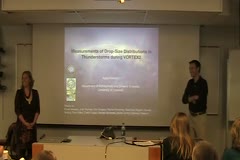
Measurements of Drop-Size Distributions in Thunderstorms during VORTEX2
February 28, 2012
Katja Friedrich
Hosted by Russ Schumacher and Thomas Birner
When studying the influence of microphysics on the near-surface buoyancy tendency in convective thunderstorms, in-situ measurements of microphysics near the surface are essential and those are currently not provided by most weather radars. In this study, the deployment of mobile microphysical probes in convective thunderstorms during the second Verification of the Origins of Rotation in…
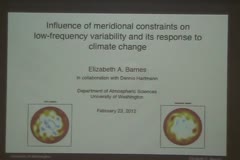
Influence of Meridional Constraints on Low-Frequency Variability and its Response to Climate Change
February 23, 2012
Elizabeth Barnes
Hosted by David Thompson
The eddy-driven jet is located in the midlatitudes, bounded on one side by the pole and often bounded on the opposite side by a strong Hadley-driven jet. This work explores how the eddy- driven jet and its variability persist within these limits. It is demonstrated that as the jet is located at higher latitudes, the leading mode of variability of the jet changes from a meridional shift to a…
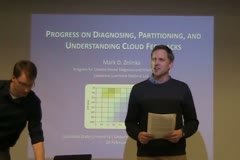
Progress in Diagnosing, Partitioning, and Understanding of Cloud Feedbacks
February 20, 2012
Mark Zelinka
Hosted by Sue van den Heever
The response of clouds to a warming climate represents one of the largest sources of disagreement among model projections of future climate change. My research seeks to quantify, understand, and ultimately constrain cloud feedbacks using theory, observations, and global climate models. Here I will present a novel technique to compute and partition cloud feedbacks. At the heart of the technique…
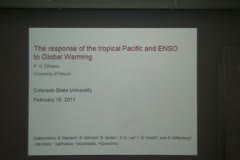
The response of the Tropical Pacific and ENSO to Global Warming
February 16, 2012
Pedro Di Nezio
Hosted by Eric Maloney
I will present new ideas explaining two central questions about the response of the tropical Pacific climate to increasing greenhouse gases:
- Is the equatorial Pacific going to become El Niño- or La Niña-like?
- Is ENSO going to strengthen or weaken?
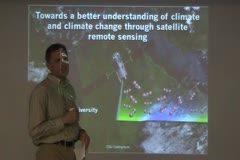
Towards a Better Understanding of Climate and Climatic Change Through Satellite Remote Sensing
February 09, 2012
Chris O'Dell
Hosted by Chris Kummerow
For over three decades, the climate science community has sought to clarify the most important forcing and feedback mechanisms related to global climate change. Significant uncertainties remain in our projections of climate change, in particular related to the myriad of feedback mechanisms in the earth system. These can operate on a variety of time scales. The "fast" feedback mechanisms,…
